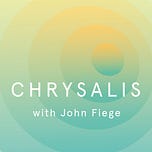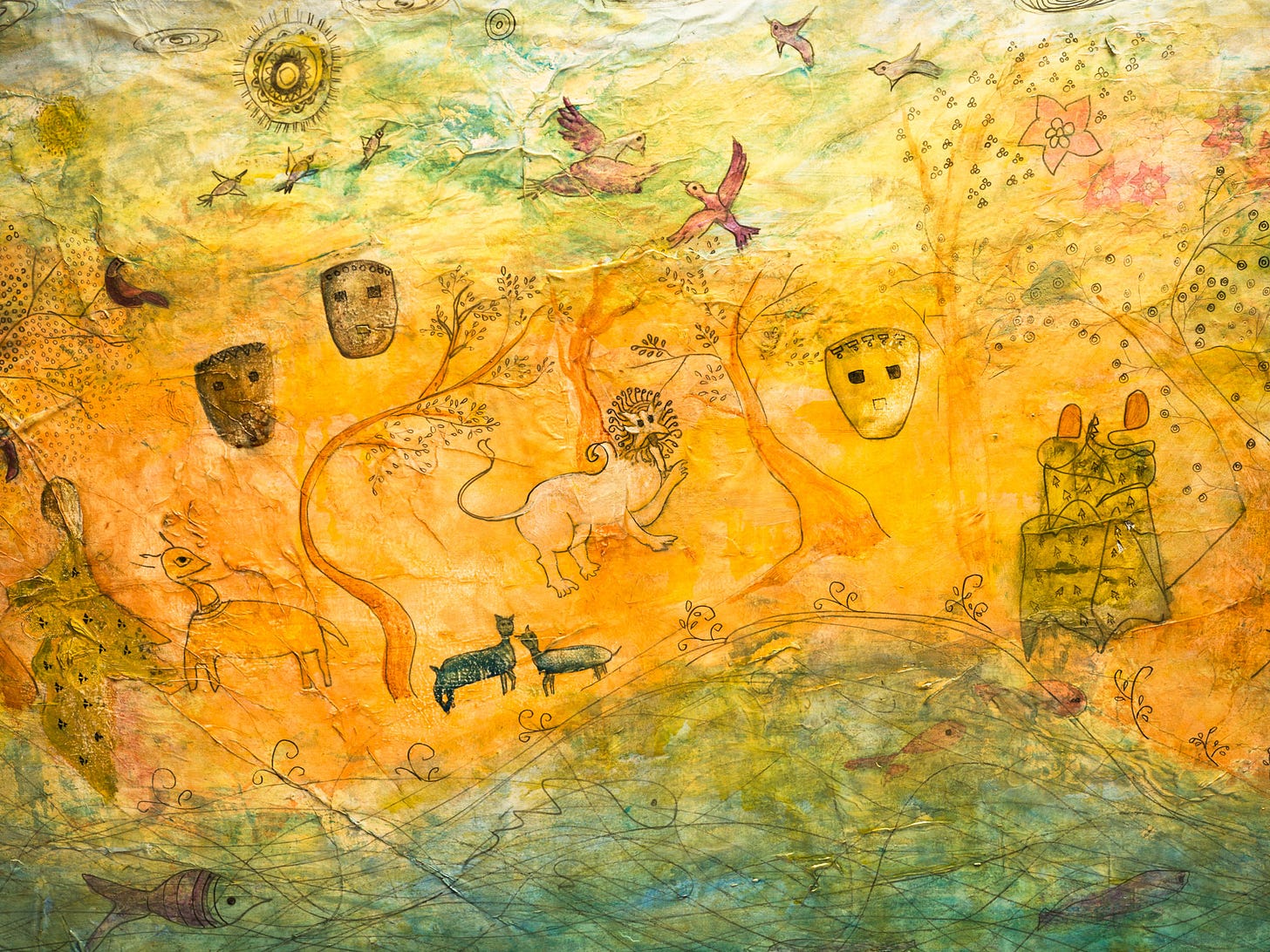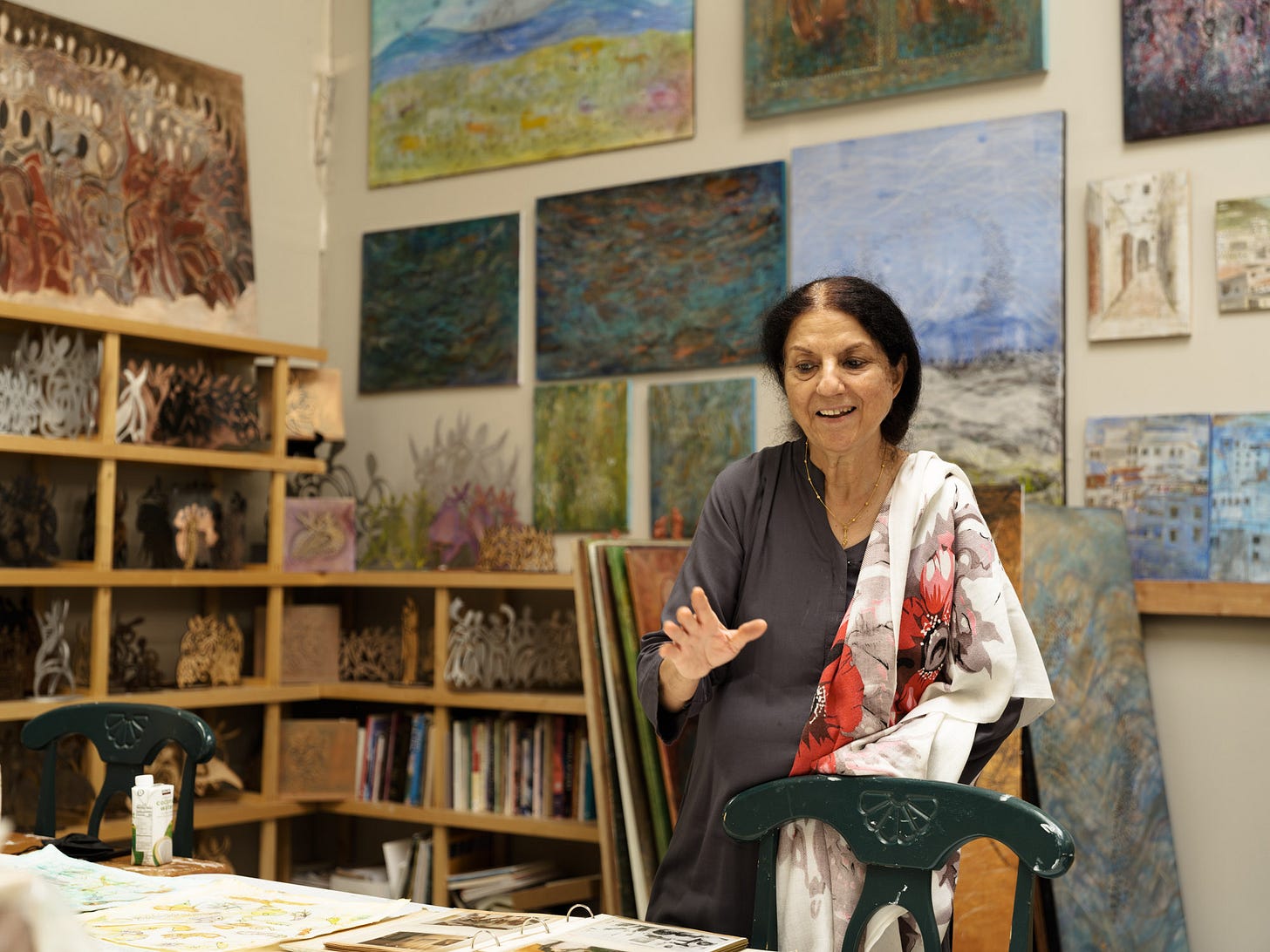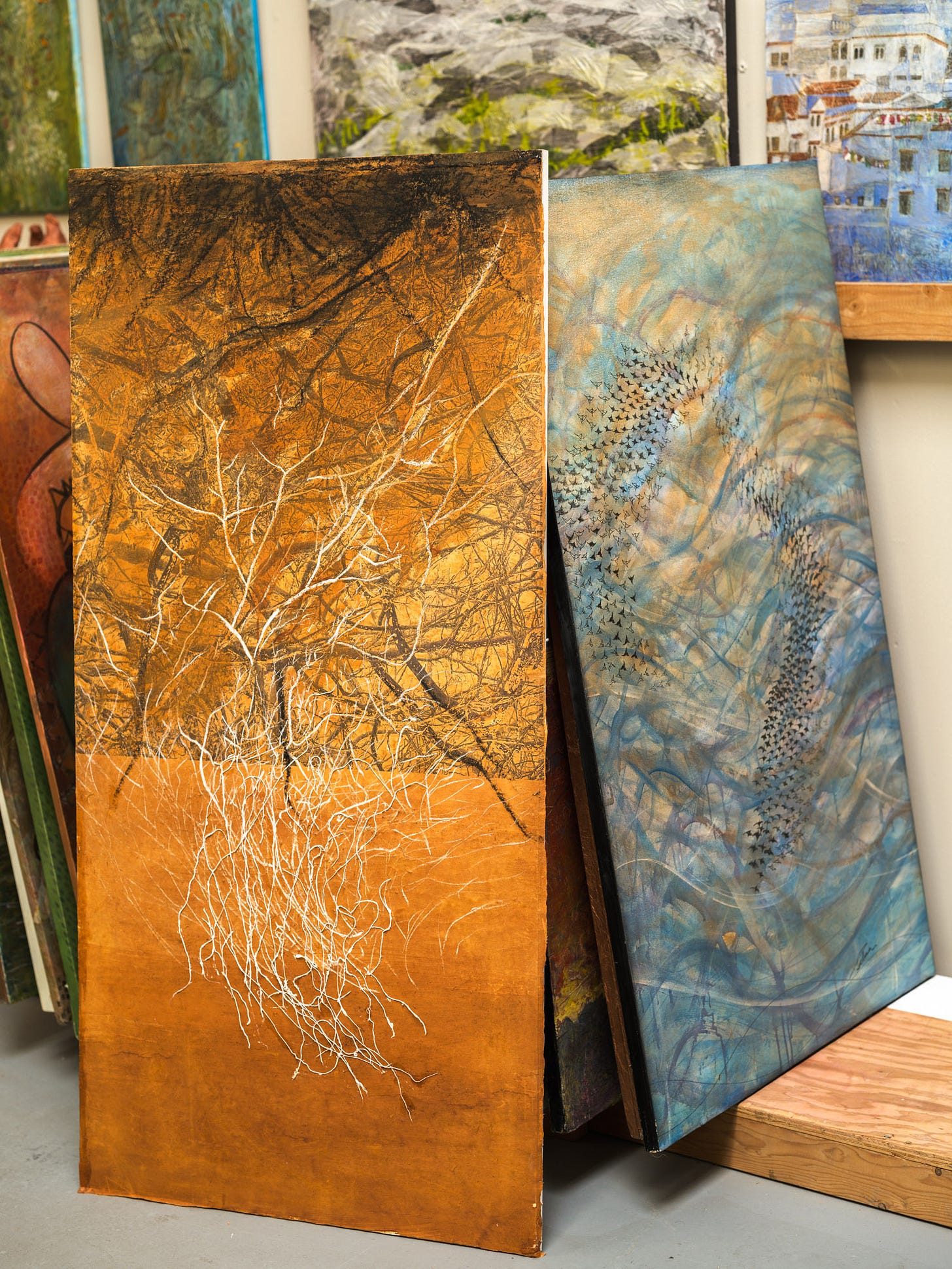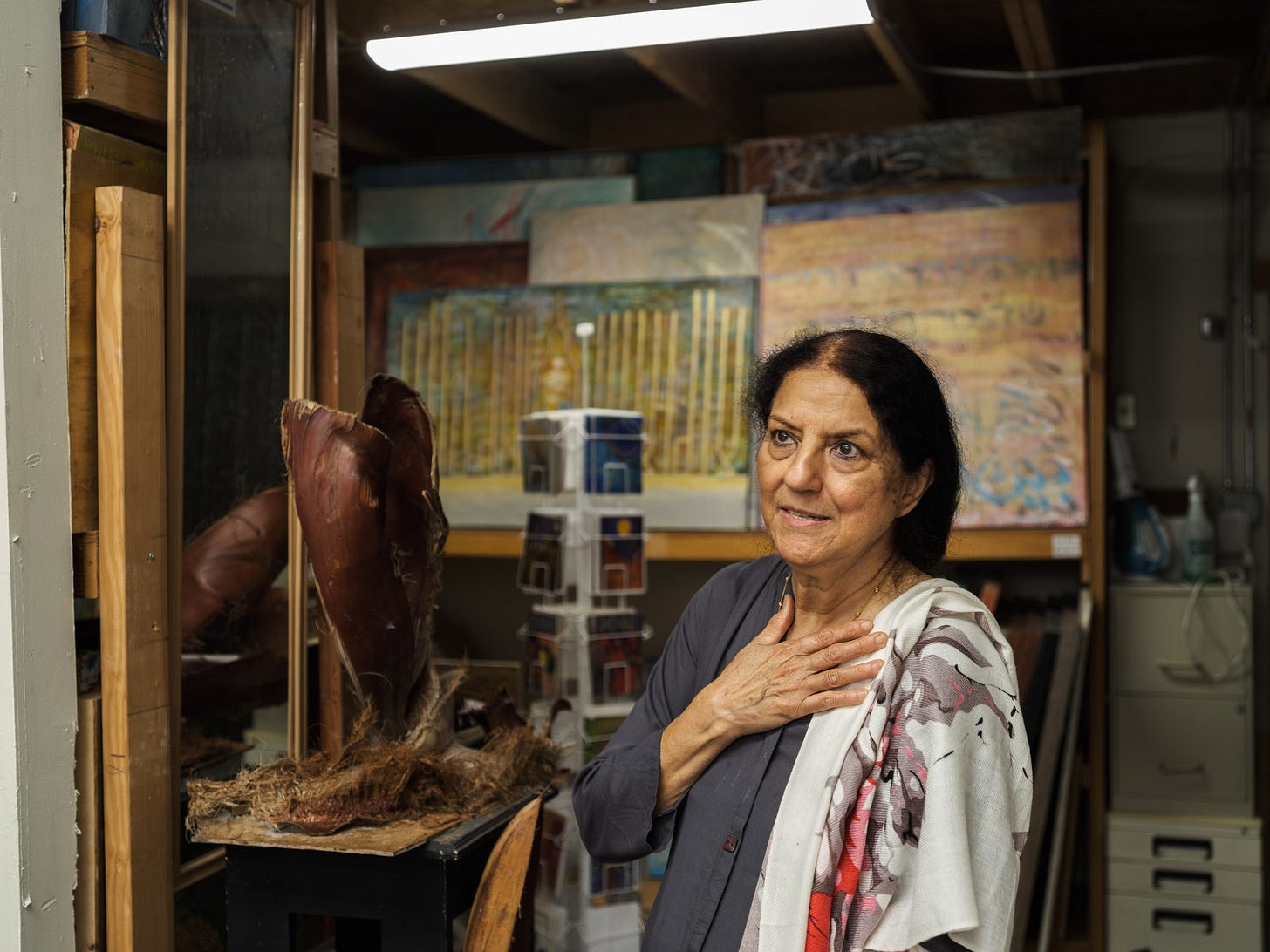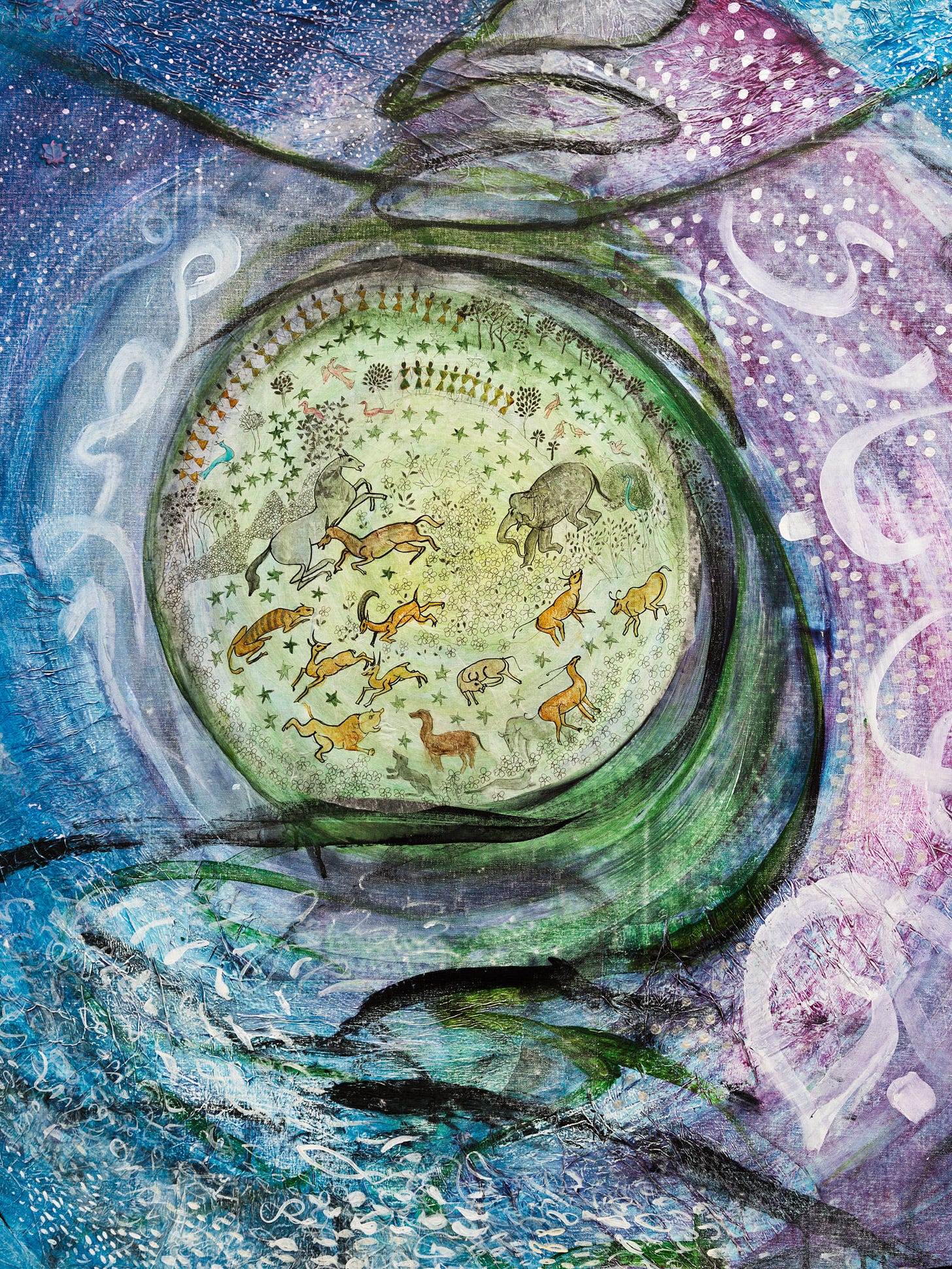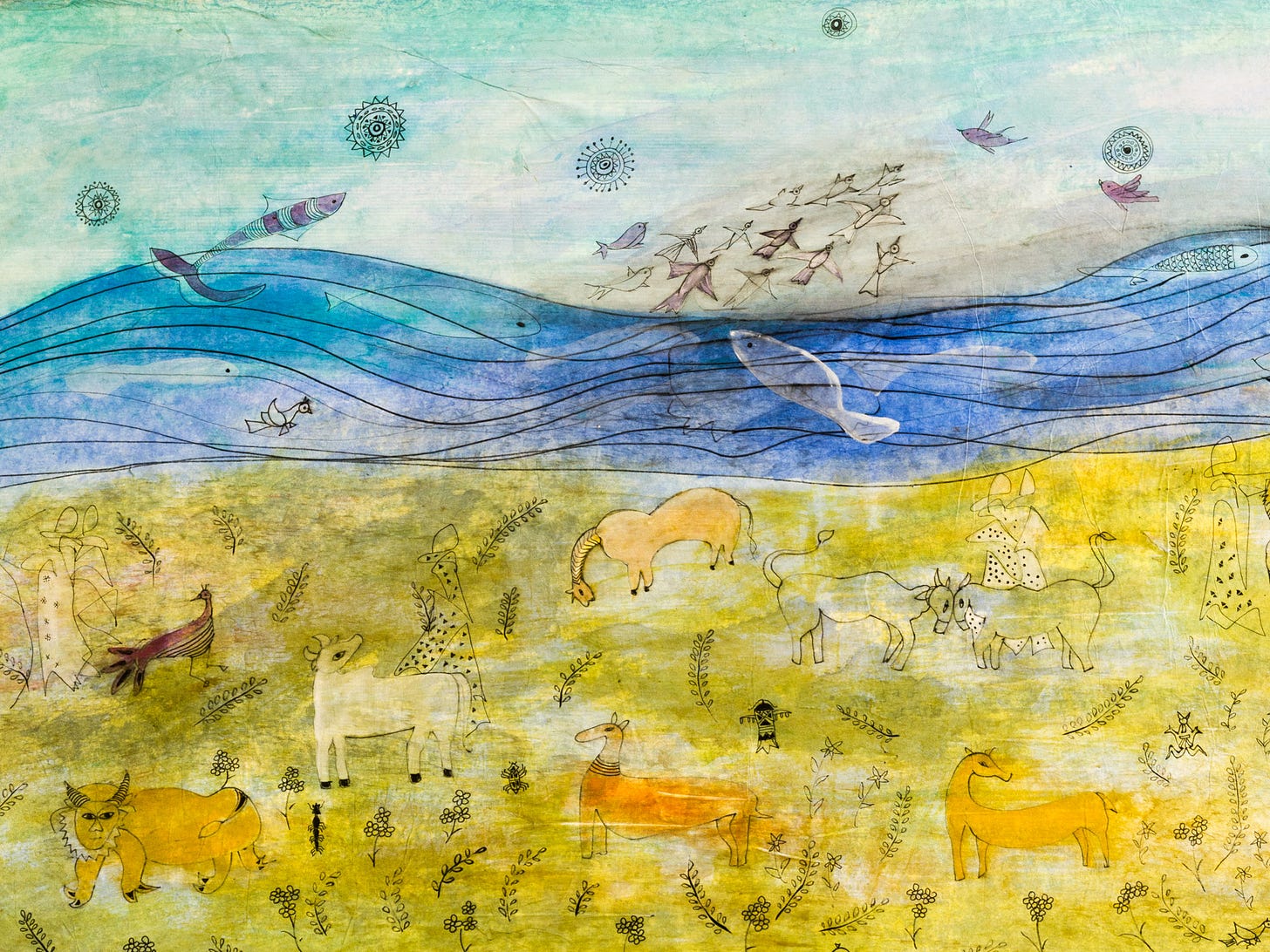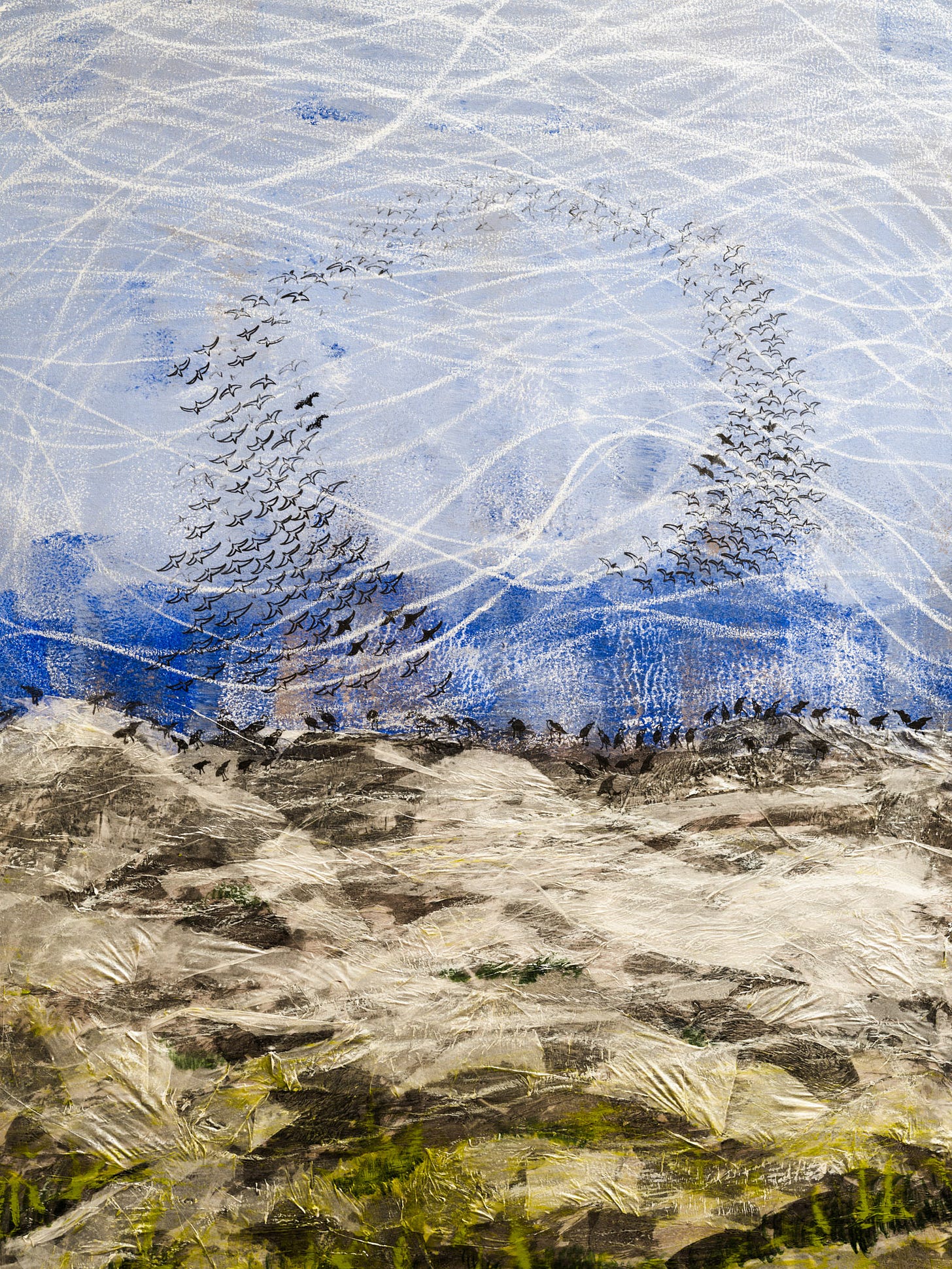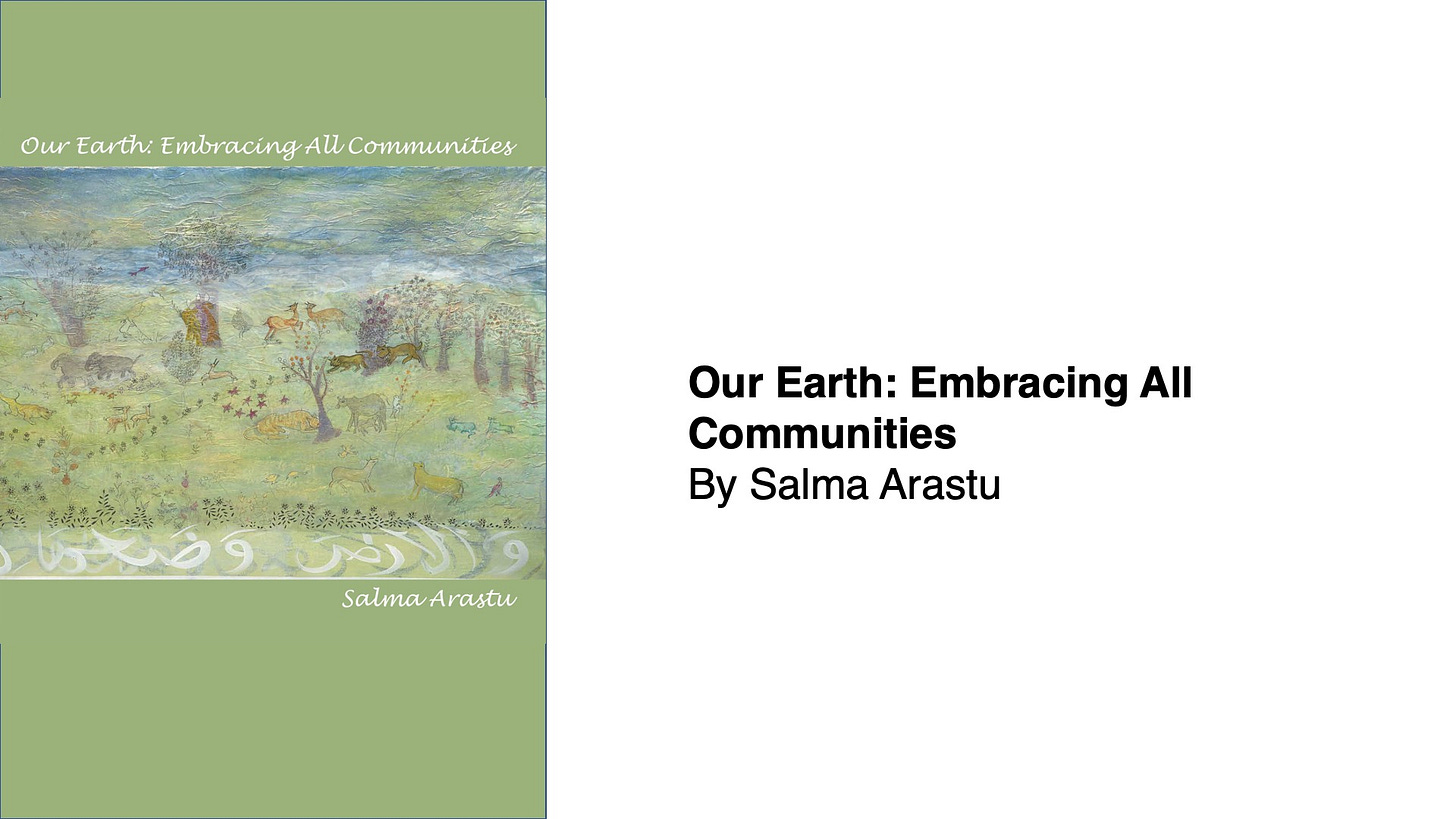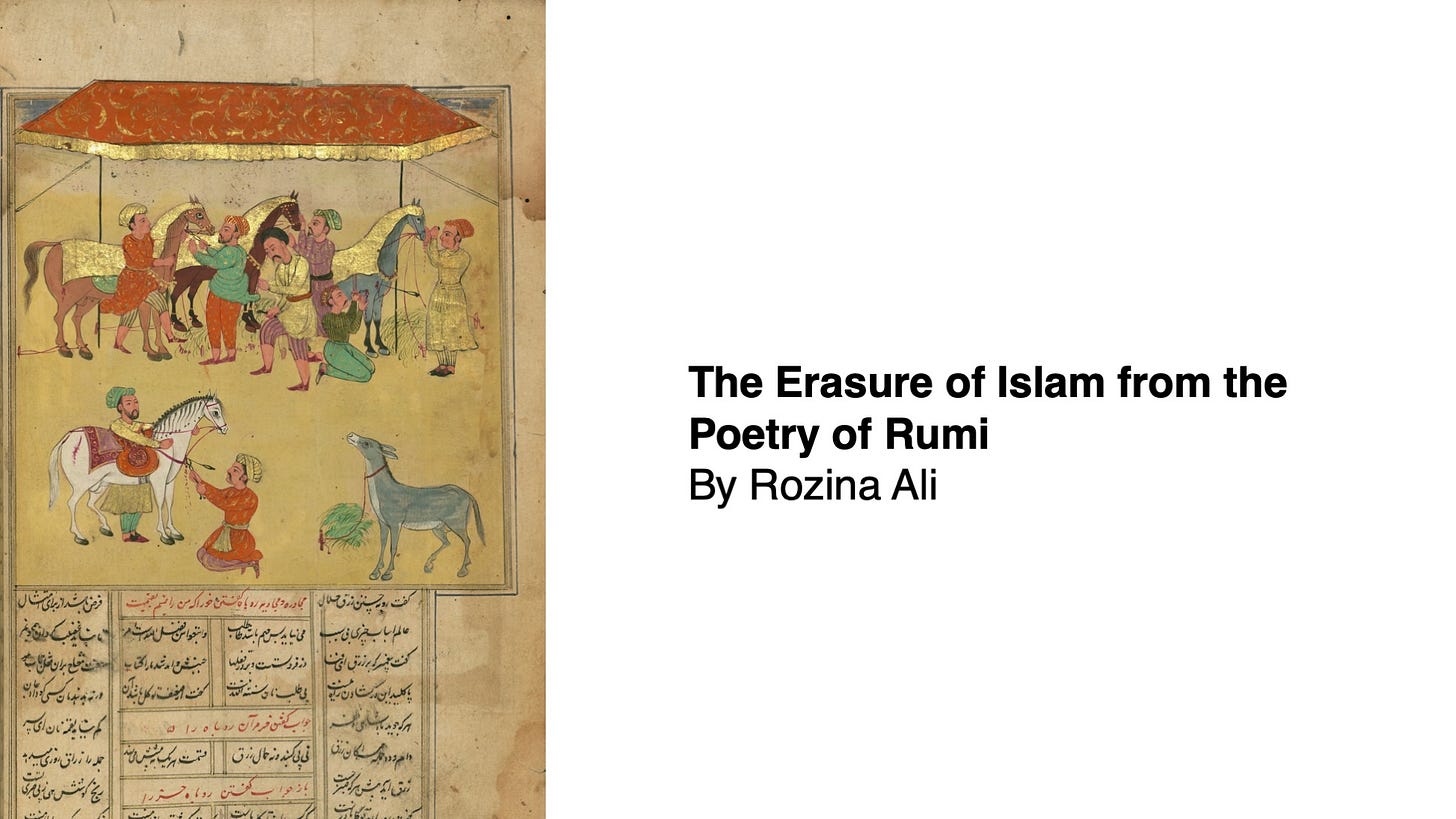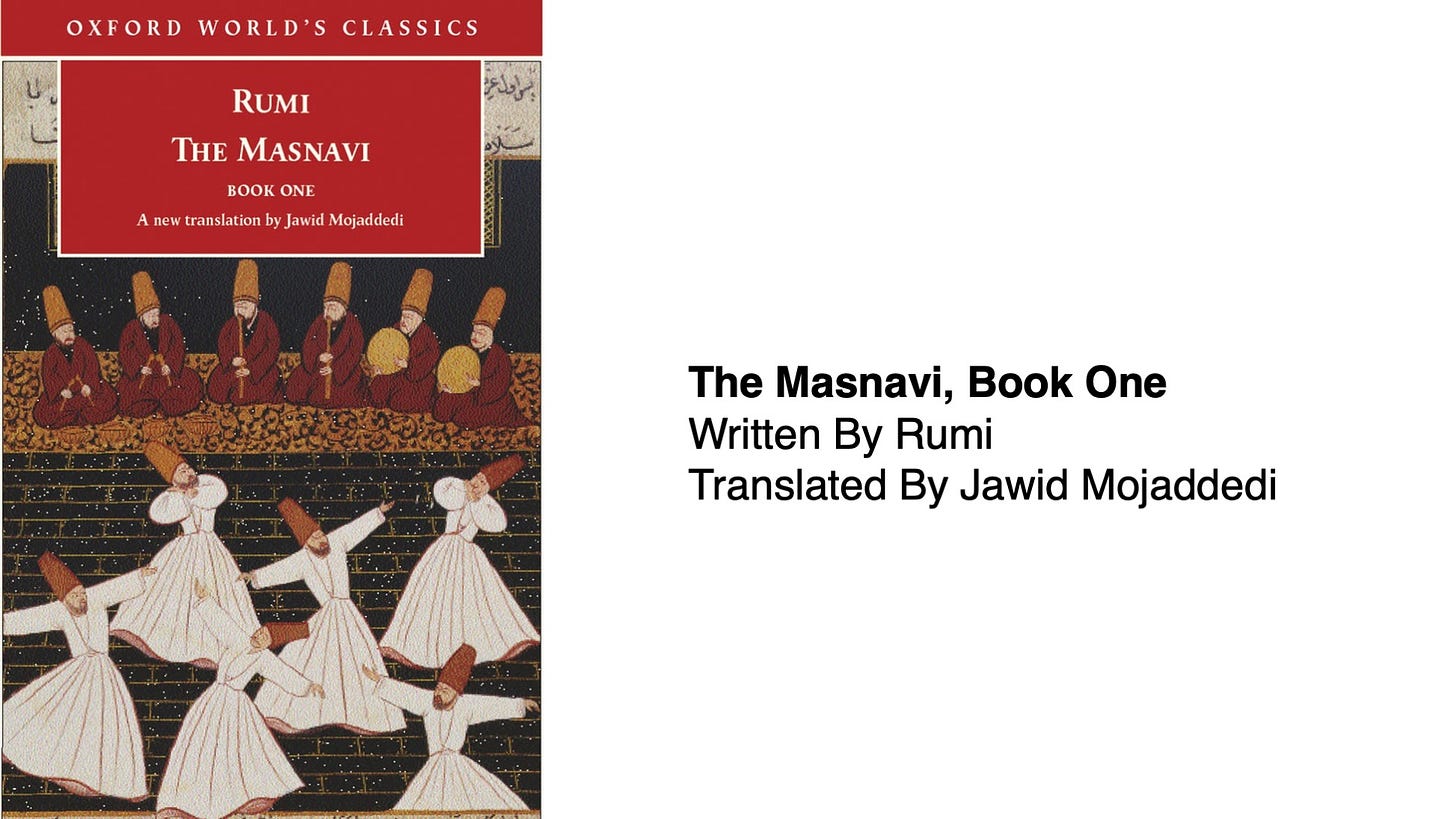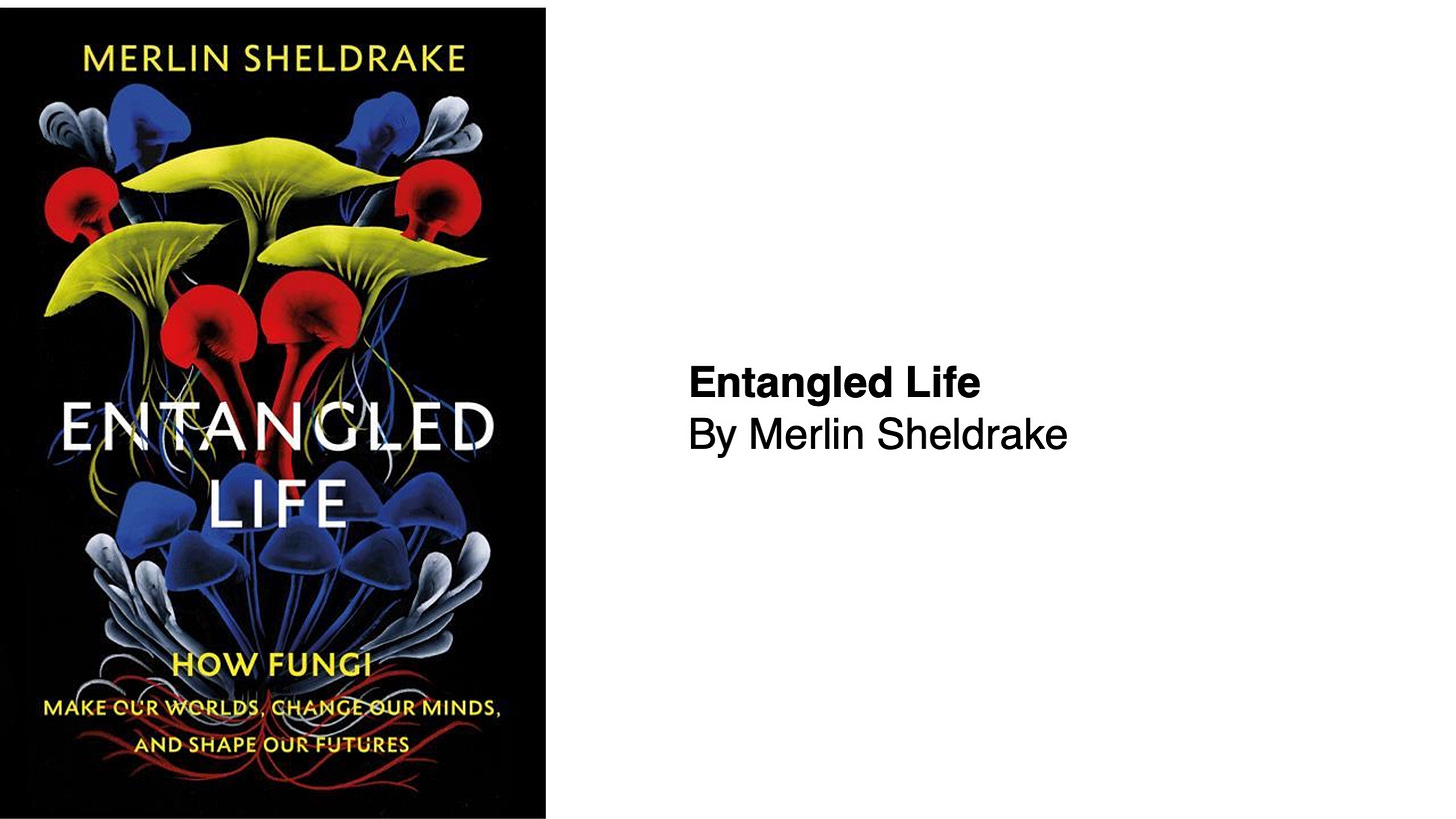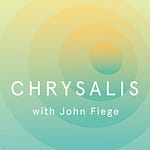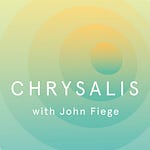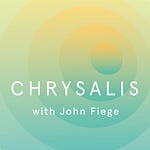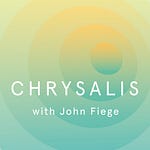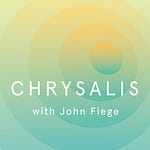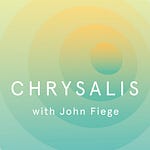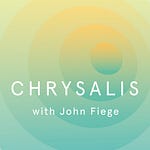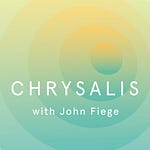Art can show us the pain and trauma and suffering of the world, and often it does. But art can also go the other direction. It can reveal the beauty, harmony, and unity of the world.
The canvasses in Salma Arastu’s series of paintings, We Are All One, are full of soft colors, continuous lines, immersive habitats that flow into one another, and—sometimes—two-dimensional representations of humans and animals occupying the same space, echoing cave paintings.
Salma found the continuous line in her study of Islamic calligraphy when she was living in the Middle East. She was born into the Sindhi and Hindu traditions in Rajasthan, India, and then embraced Islam after marrying a Muslim.
It was this continuous line that became a central element of her approach to painting and a central technique she uses to express the ecological views she finds in the Quran.
She seeks to transcend difference through her art and find oneness and interconnectedness in a world that continually ravages ecological systems around the planet.
Since the 1970s, Salma has been exhibiting her work nationally and internationally and writing about art. She currently lives in San Francisco, where I had the pleasure of visiting her in her studio and seeing so many of her wonderful paintings.
This episode is part of the Chrysalis Artists series. You can listen on Substack, Apple Podcasts, and other podcast platforms.
Please rate, review, and share to help us spread the word!
Salma Arastu
An Internationally exhibited artist, Salma was born into the Sindhi and Hindu traditions in Rajasthan, India. She later embraced Islam and moved to USA in 1986. Her work creates harmony by expressing the universality of humanity through paintings, sculpture, calligraphy and poetry. She was inspired by the imagery, sculpture and writings of her Indian heritage and Islamic spirituality. She was born with a left hand without fingers. Because of her all-encompassing God, she was able to transcend the barriers often set-forth in the traditions of religion, culture, and the cultural perceptions of handicaps.
After graduating in Fine Arts from Maharaja Sayajirao University in Baroda, India, she lived and worked in Iran and Kuwait, where she was exposed to a wealth of Islamic arts and Arabic calligraphy. Calligraphy, miniatures, and the folk art of Islam and the Hindu tradition continue to influence her work today. She has been invited to Germany twice, as a Resident Artist at Schwabisch Gmun in 2000 and by the Westphalia Wilhelm University in Münster to publish her paper “Art Informed by Spirituality” in God Loves Beauty: Post Modern Views on Religion and Art. Further she was invited to Morocco for a one- month Artist Residency Program in March of 2018 through Green Olives art Gallery. She has presented work at Stanford University, Commonwealth of San Francisco, Seattle University, Graduate Theological Union at Berkeley, and Museum of Contemporary Religious Art, St. Louis Missouri.
She has displayed at 45 solo shows nationally and internationally and has won many distinctions: the East Bay Community’s Fund for Artists in 2012, and 2014, and 2020, The City of Berkeley’s Individual Artist Grant Award in 2014, 2015, and 2016. She has public art pieces on display in Bethlehem, Pennsylvania and San Diego, California and has written and published five books on her art and poetry. Her most recent book deals with ecological consciousness from Quranic verses “Our Earth: Embracing All Communities.”
Selected Works
A more comprehensive collection of work is available here.
Recommended Readings & Media
Salma Arastu Sharing process of her art.
Transcript
Intro
John Fiege
Art can show us the pain and trauma and suffering of the world. And often it does. But art can also go the other direction. It can reveal the beauty, harmony and unity of the world.
The canvases in Salma Arastu’s series of paintings, We Are All One, are full of soft colors, continuous lines, immersive habitats that flow into one another, and—sometimes—two-dimensional representations of humans and animals occupying the same space, echoing cave paintings.
Salma found the continuous line in her study of Islamic calligraphy when she was living in the Middle East. She was born into the Sindhi and Hindu traditions and Rajasthan, India, and then embraced Islam after marrying a Muslim.
It was this continuous line that became a central element of her approach to painting and a central technique she uses to express the ecological views she finds in the Quran. She seeks to transcend difference through her art, and find oneness and interconnectedness in a world that continually ravages ecological systems around the planet.
I'm John Fiege, and this episode of Chrysalis is part of the Chrysalis Artists series.
Since the 1970s, Salma has been exhibiting her work nationally and internationally, and writing about art. She currently lives in San Francisco, where I had the pleasure of visiting her in her studio last summer and seeing so many of her wonderful paintings. At ChrysalisPodcast.org, you can see some of my photos from that trip and images of her paintings, including those from her We Are All One series.
Here is Salma Arastu.
---
Conversation
John Fiege
Could you start by just telling me a little bit about your project, We Are All One?
Salma Arastu
Yes, I believe in oneness. And these are kind of my oneness projects, you know, like, I want to bring the whole humanity together. And in my work, initially, they were abstract figures, you know, that they are coming together in groups, you know, celebrating together, sharing together, chanting together. So this has been my theme always. And from that, you know, gradually, as I was looking around the nature, I live on the bay in this area. And so nature has been great friend, I would say, you know, I keep watching the plants, the water, the clouds every morning. So this has been part of my daily schedule that I look at the nature and absorb it and go to my studio. And so somehow the nature, the the birds, the animals, and the plants, they all got into my work, and I realized we are all one, we are all breathing, we are all connected. So I think gradually I started doing work, which showed all living beings in my work, and I call it We Are All One.
John Fiege
Great. And And can you talk also about Our Earth, and as part of this project, and what did you do there?
Salma Arastu
As a daily practice, I do read Quran, my book of faith. And, you know, suddenly I started noticing the verses, which talk to me about the planet about, you know, like Earth and the communities. So let me tell you the first verse, which really, really was holding me for some time, you know, before I started the project, and that verse was so related to my thinking, we are all one. So that particular verse, it says, “There's not an animal in the earth, nor a flying creature flying on two wings, but they are communities like you.” So then I went to the description of that verse and amazing results I found because different scholars have given the beautiful description of this verse. And understanding this verse was like a divine invitation to follow the concerns of these all ecologists in our time. So I went deeper into it. And then especially one scholar, Dr. Fred Denny, who said, “The verse presents a paradigm of interconnectedness. Communities necessarily interact with one another. And we are enjoined by the Quran to view the animal world, not merely as parallel to us and organized into communities but signals interconnectedness between their existence and well being and our own, as no community on Earth exist in isolation of the others, and what affects one community ultimately affects other communities.” So this was amazing revelation to me. And then I started you know, noticing these verses which talked about the plants, the mountains, the ships, the see the fish, you know, the ant, bees. It was a beautiful revelation for me, and I started noticing them down and I found 90 verses like that, almost, which is my limited knowledge, you know. Then I started to shorten the list because I really wanted to do this project. I said I want to bring this positive from Quran to the mainstream in the world, so they understand the positive side of Quran.
John Fiege
Oh, that's great. Yeah and it seems like with that project in particular, it's almost a theological process of, it’s almost like through art you have been studying the Quran. Is that accurate?
Salma Arastu
Yeah, I would say through, yeah, through my art, I was reading Quran, in the sense—or from Quran I was doing art. In Quran, the God has ordained us to look at the nature to study the nature, because—I read something here. “Quran describes nature, presents signs of God, as divine is manifest in nature, and guides to study nature as reference to the wisdom of Quran.” So in fact, as I understand, Quran is a textbook, and the nature is a workbook. Believe me, and that's how I worked on it.
John Fiege
Oh wow. That’s great. Yeah and and my understanding of Islamic law is kind of these basic elements of nature, like land, water, fire, forest, light, are all living things, not just humans and animals as living things.
Salma Arastu
Yes, yes.
John Fiege
You have a really interesting relationship to the Quran and to Islam, and to religion in general, really, your parents were Hindus who fled Pakistan during partition, and settled in Rajasthan in India, is that, is that all right?
Salma Arastu
Yeah. Yeah, that's right. Yeah.
John Fiege
But but then you ended up marrying a Muslim man, and living in Iran and Kuwait, and eventually the United States. You've also talked about the importance of your mother, who is a devout Hindu, in your developing spirituality. Can you talk about a bit about this spiritual journey and how it's infused in your art and how it's led you to engage deeply with ecological subjects?
Salma Arastu
Yeah, sure. I think I do give credit to my mother and my bringing up, because though she was, you know, I mean, they were refugees from Pakistan, when I was born in India. So in the sense, though, my father has started the practice, he was a doctor, he was a physician, but he had lost everything like, you know, in Pakistan, and he was very depressed, but my mother was very, very positive thinker. So she always said, things will be fine. I remember, as a child, you know, my father used to be so upset and angry at times and more in the night, you know, say, I have lost everything, they have not given me back anything, so but she would always calm him down. So that's how I'd always seen it. And the other thing she kept telling us, We are all same. And because in Ajmer where I was born, the Rajasthan, the city in Rajasthan, it has the both pilgrimage you know, Hindu and Muslim. So like, she has seen all that. And she always told us, No, we are all one. We are all one actually came from her thought, you know, that we are all connected, we are not different. So I carried that thought all through my life. And when I met my husband, I tried to restrict myself, I tried to hold myself back. But somehow, somehow things happen. So I said, this is the this is the God's will, you know, that I marry this man. So my mother, though she was very disturbed, but she blessed me. And she said, your destiny is with you. But my blessings are with you.
John Fiege
Wow.
Salma Arastu
So this is all I needed. So I got married. And I'm grateful because we have been married for 47 years now. And it has been a blissful journey. Yes, my husband is very supportive of my art. And the family, also, my children also. So somehow, it's a beautiful journey. And I'm very grateful for that.
John Fiege
So when you were living in the Middle East, you began studying Islamic calligraphy. And you discovered the continuous line as you as you call it, you've called it your guiding line and the light that leads you, and I love how this technique of the calligraphic line complements so strongly the themes of unity and connection in your work. Could you talk about calligraphy a bit, what it means to you, how it’s influenced both your art and your ecological thinking?
Salma Arastu
Yeah, so what happened when I did my masters from India, I was doing abstract work, but nature only, you know, it was movements of nature I was doing. I didn't know anything about Islam. I didn't know anything about Quran, I didn't know anything about calligraphy. So when I went to Middle East, I love this calligraphic the continuous line, you know, I used to copy it. And there was one quote from one Islamic scholar who said that the calligraphy starts from the field of action, it starts on right, you know. So it starts from the field of action, and lands in the field of heart. So, it was so beautiful, and I think it stayed with me. And then I started learning Arabic slowly, because, you know, I was curious, what do they say? So then I started making the sense of those words, and I was amazed at this line, how it's making the meaning also. But before I went deeper into the meanings of Quran, this line became my language. And when I came to USA, I continued with those abstract figures and you know, my lines, but then 2001, when this 9/11 happened, after that, I got a jolt, you know, like, it was something, people started asking me because I was known as a Muslim artist, you know, so they would ask me, Is Islam like that? Do you believe in that? So I said, No, my God is same. My God hasn't changed. So he is not Muslim. He is not Hindu. He is not Christian. So he is not like that. It cannot be like that. So there's some, something wrong gone somewhere. So I started learning Quran.
John Fiege
Where were you? Where were you living during that? When 911 happened?
Salma Arastu
I was in Pennsylvania. I was in Pennsylvania.
John Fiege
Okay, so did you see a lot of that? Like, anti-Islamic backlash?
Salma Arastu
Yeah, exactly. Islamophobia. Yeah, because suddenly it happened. And I watched it, and it hurt me also, like, I was in tears, watching the falling of Twin Towers, because I used to visit that place. So I'm just saying it affected me a lot. But then I started learning about Quran. And seriously, it gave me such positive thinking like, such positive verses I have found, you know, which talk about hope and unity and connection and earth. And then now I say that my work is about oneness, connecting humanity, soil and soul. So that is my tagline nowadays, you know?
John Fiege
Awesome.
Salma Arastu
I'm trying to connect humanity, soil and soul. Yes.
John Fiege
That's great. And, you know, one thing I was thinking about is representational and figurative art are generally discouraged in Islamic art. And I think in your early work, it was all abstract. But in, in some of your paintings personally, more recently, you represent plants and animals, and even people, although the people seem to always be faceless in some way, you know, the heads are generally represented with just circles. But I was just wondering how you see your work within the tradition of Islamic art and the precepts that come with that?
Salma Arastu
Yeah, so frankly speaking, I was, I knew about it, people say that, like I did faceless figures without realizing that Islam, it's not allowed. But then I talked to some scholars, and I was told, it's only the sculpture form, because, you know, in Islam, the worship of icons is private. Okay? So it's not that you cannot draw. What he what I was made to understand that if you make a sculpture, and then you make it a human-like, so that is not allowed, like, because you cannot create a human. If you see my work, it's very folk style. That there, I'm not doing exact three dimensional, you know, figures. And even if you go back to books, the miniature paintings, and which talk about the story of Islamic periods, and all that, they are also two dimensional, you know, they’re, nothing is three dimensional. So what I'm trying to say that it is allowed in the story form, in fact, in my book, there's a last page, which a scholar wrote for me, in favor of my work, saying that Islam is allowed. “Prophet Muhammad was known to praise diverse forms of beauty and to have said Allah is beautiful and he loves beauty. All of these meanings and more find the holistic expression in the Quran and Sunnah, and are subtly unveiled, explored and expressed in Salma Arastu’s paintings, and the English translation of the verses presented with them. Through her work cell mitosis encouraging the viewer to contemplate important meanings of unity, justice and balance as well as the impact of human actions the need for oneness and universal care for creation, all of which are indeed among the higher objectives of this Islam.” So that's how I did it. I don't know, I was inspired. I was, rather I would say I was guided to do it like that, and I did it. But so far, I haven't heard any, any criticism on that.
John Fiege
Well, that's great. And you've also described your process as very physical: scratching, sanding, layering materials like paper, rope, modeling paste, paper mache, or copper plate, embroidering with pen and ink. How does the physicality of your technique relate to your work, which is very much about both the physical biological world, but also spiritual existence?
Salma Arastu
I like textures. You know, I don't know, I like the penetrating textures. And some are right from beginning, I used to use paper first, you know, and then I used to, like, glue the paper on the surface and create, you know, textures and then paint gesso on it. And then I work sometimes, I'm a lot of sanding, because I like to show the layers beneath, you know. I don’t know, I'm so physically involved with the work,I mean, that I can't describe, you know, I don't know, it's a new, it's a new experience each day, you know. The new painting that I'm doing, I'm using rust as my paint, I create this rust with a vinegar and aluminum and you know, make them rust, you know, make it rust color, and I paint with that also. So, and I'm using rope in my recent work. So yeah, I love textures. And I like pen and ink, I mean, I don't know it’s the calming me down. You know, when I do the large works, the different works with a lot of physical work and like a lot of textures, then pen and ink is something which calms me down, it brings me back to myself. And it's like a meditation. So all my paintings have some work in pen and ink. It's like embroidery, I call it you know, it's like putting my you know, final touches on my work.
John Fiege
That's great. Well, I'd like to for a minute look at a specific painting, and one of my favorites is called Earth and Skies. And so on one level, when you look at it, it's a traditional landscape painting in the sense that, you know, the bottom half of the canvas is green for the land, the top half is blue for the sky. But when you look closer at it, you realize that the sky is also the ocean and teeming with marine life. There are animal figures, both terrestrial and marine animals. And they, and as with all your work, it's drawn in two dimensions. And in some ways, it's reminiscent of cave paintings, I've found. And the entire canvas has this two dimensional flatness, with no sense of depth at all. And interestingly, there are some human figures in the landscape. It's not this idealized wilderness landscape devoid of humans. But the humans blend into the background and are represented in a similar size and style as the other animals. I also love your color palette, it's all these soft colors that that dissolve into one another. And of course, your your fluid lines are everywhere in the piece. Can you talk a bit about the techniques and concepts behind Earth and Skies? And like how do you create these colors that flow and dissolve into one another and, and, you know, you just your process for for conceiving and and creating this.
Salma Arastu
Sure. So as I told you, I work with very thin acrylics. And my I don't make sketches of my paintings, I go directly on the canvas, and I feel guided you know, like, whatever comes is coming from within me, from within me, from my soul through my hand on the canvas. That's how it is. I don't know what is going to come on the canvas. So that particular theme, the earth and the skies, comes from a verse from Quran which talked about the balance. It said that God has created this establish this balance of earth and water in the skies, and don't disturb that. So, so that was the main concept in my mind when I started working. And somehow these soft colors, they, you know, I started with very thin paint very, very thin pane, and I started drawing animals, fishes, because I'm showing the connection. So for me, the birds, the fishes, the animals that are all part of this balance, you know, even the human figures. Here I want to mention one thing somebody told me recently and I love that concept. The man thinks he's the great and he's the protector, you know, taking care of this earth. While he's not needed to take care of earth, God is taking care of everything. Human being is just part of this whole system. You know, the whole web of life. It’s the ego of the human, you know? So the word I was told that even the caveman knew that human figures don't, don't mean anything, like they are just part of it, because he always, the caveman also drew the figures as the sticks, and did the beautiful drawings of animals.
John Fiege
Right, right.
Salma Arastu
So I really like that concept. I said, that's beautiful. Yeah. So this one, it just developed, as I told you, like, it just happened, you know, like, one layer over another, and another and softly I was going with very light colors, because I, it had to come through that, you know, and then I do a lo ton sanding. So in that painting, I've done a lot of sanding to give it an antique feeling in the bottom part with the figures. And it's a slow process if you ask me. But but it happens very spontaneously.
John Fiege
That's an amazing combination. Slow, but spontaneous.
Salma Arastu
Yes. Because whatever comes out, it comes out. And then I wait, I look at it. And then I go to it again, again throw some color on it, and then come back.
John Fiege
Well, that seems to go back to this idea of the process of art as meditation or contemplation or study. It's like the, the processes.
Salma Arastu
Yeah, it's a dialogue. You know, it's a constant dialogue between the work and artist.
John Fiege
That's awesome. There's a, there's another painting, I really love, The Waves and the Birds. So I love this painting, I just, I just visually love it in the colors. But also, the birds are flying in a flock through, you know, seemingly through the ocean. But it it creates this sense of the parallelism between a flock of birds and a school of fish, because they kind of look like a school of fish swimming through the ocean. Can you talk a bit about that piece? And, and where that came from?
Salma Arastu
Yeah, yes, you know, I walk on the bay, as I told you. So I often see this, you know, swarms of birds, you know, flying in, in fall, you know, they come, the migrant birds, and they sit there, and they are just moving around, you know, it's like a constant flow. The waves and the birds, you know, I don't know, it just remained in my mind. So one day, it came like this on a canvas. So because there's no end, the waves are till the top, you know, because I see the whole bay area, you know, and then I see this burst just going over it. So this painting, it happened again, you know as I told you, they, they just happen for me, I don't plan them. So when I was going to do the birds, you know, I took my pen and ink because I didn't know how to show the birds. You know, I didn't want to mix them with my paint also. So I just did those with pen and ink if you see, so it was a very, I don't know, it just happened. I mean, that's why I always say I'm guided. I don't know why I'm doing it, how they come. But it really came together really well. And I'm so pleased with the composition. I know even I like it.
John Fiege
Yeah, the composition, the composition is amazing.
Salma Arastu
Yeah, thank you.
John Fiege
Often you, I know you write poetry. And, and some of your paintings have been accompanied by poems, both your own poetry I think and I think you sometimes pull text from the Quran and other places. Can you talk about that relationship between poetry and your painting work?
Salma Arastu
Yeah, you know when I'm walking in the morning at the bay, you know, a lot of thoughts come in my mind. I feel so full of inspiration, you know, when I come back, I want to do this today, I want to do this day. So I record my words, and I record my whatever thoughts are coming and come back in my studio. So sometimes first I write the poem, which is which came in the morning, you know, in my mind, and then go to the painting, then start the painting. I don't really sketch but the words you know, sometimes the words helped me to portray what I want to do that, like my thoughts, you know, so they're connected. I know many times poetry happens first, the painting happens, you know, not for every painting, some. And sometimes the painting happens and when I look at it, it gives me the dialogue of in the form of a poem, you know, so, so they're interrelated in my work, and sometimes I'm directly influenced by Rumi's poetry also, because it's very universal. My work is not necessarily Islamic or Hindu or Christian, or American or Indian. I think my work is universal. I'm painting for everyone. And I, this is what I want to be. You know? So that's how I connect myself with Rumi.
John Fiege
Yeah. Well, he is such an interesting figure, as you say, who is admired by so many different groups that see themselves in such strong opposition to one another in the modern world. And we really live in this age of identity and difference, and across the political spectrum it's really in vogue right now to emphasize and amplify difference and division in culture, race, religion, gender, age. But you're really going in the opposite direction, searching for universality, unity, love, and in some ways, those are ideals from the past. But at the same time, it feels like in the cyclical world that we live in, that they—
Salma Arastu
We need that.
John Fiege
Yeah, that's maybe what the future is, as well.
Salma Arastu
Exactly. That’s what I'm hoping for, yes.
John Fiege
How do we, how do we counteract this toxic political and cultural division that we have in the modern age and, and the ecological calamity that comes with it? And how do you how do you think about these issues of identity and difference and universality and unity?
Salma Arastu
Yeah, let me tell you, you know, it pains me, I cry, when I see these things around me, I mean, like this, this is torture, being a such person. And then watching these separations, you know, watching these distances, watching this, more and more split between, you know, nations and communities and races. Like, sometimes, you know, I see other artists doing this pain, oh, painting this, pictures of pain, but I can't do that, you know? I'm so full that I can't describe the pain. I think if I also do the pain, what I'm here for? I want to give hope, I want to give that love, I want to give that, that that feeling of you know, compassion. I have done few paintings, which depict the moment of the pain sometimes, but then it makes me cry. I said no, I cannot do this for long. I have to give the hope. I cannot do the same like everybody else is doing. What is my existence then? So think I, I don't know, I feel I'm here to give some message of love.
John Fiege
Right? Yeah. And you've talked in about your work in terms of, you know, this bringing together of Eastern and Western traditions. You know, you're using a lot of Western techniques in your work, but then you're bringing in a lot of these philosophies and approaches to the world that that are much more associated with the East.
Salma Arastu
Yes. Yeah, that's a beauty. You know, I love this western world because I've learned so much, you know. I mean, I have been influenced by art from West, I have loved these techniques, the new new techniques I learn every day. I mean, there's so much to learn, I can't keep up with everything. But I say my what I want to say. So, and just naturally, I'm not emphasizing, I'm not forcing myself to do it, as I told you, I just do what comes from within me and just from through my hand on the canvas, so I just continue like that, you know, because I have surrendered myself to the Creator.
John Fiege
Right. Well, I think when you look at the paintings, you can see this spiritual process, which I find really amazing.
Salma Arastu
Thank you.
John Fiege
And the, you know, the deep contemplation just infuses your work, which is, which is really beautiful.
Salma Arastu
Thanks. Thank you, I really appreciate, yeah.
John Fiege
So your, some of your new work that's that I think is coming out of the same project is these paintings around mycelial networks, which are the, you know, the white fungal threads that create these vast underground fungal networks that scientists have recently discovered to be really critically important to communication and nutrient flow and, and ecological connections between lots of species of plants and animals. And, and, and one of my favorite paintings, you know, you described earlier how you're working with rust, but it's got this rust background and these bright white mycelial networks. Yeah, and I love it. And it's just so just the colors and the textures, even on a computer screen are so striking. Can you tell me about the origins of this mycelial work and what mycelia have taught you about ecological connection and regeneration?
Salma Arastu
Yeah, so you know what happened when I finished my project Our Earth in 2021, and then I, you know, I can't stop myself. So I started looking for the solutions now. I know these are the problems, these are the happening things. But now how do I find a solution? So I started reading science. I never did before. But you know, I saw this Fantastic Fungi. Have you seen that movie?
John Fiege
Oh, I haven't seen the movie. But I've read–
Salma Arastu
Oh, yeah. So what happened, when I saw those mushrooms and when I learned about the how they're beneficial, so mycelia seem to be giving the better future you know. That if only we concentrate and look at it and learn from it and support these organizations who are doing research on it. They're trying to make plastic like things from mycelia, I want to make people aware of it. You know, being an artist, I can creatively create those images which will attract people and they'll ask me what it is. So and especially it again, line, I have been so involved with these lines, you know, I'm so enjoying them, the roots and entangled life and then I'm reading some books also which are inspiring me. Entangled Life is a beautiful book, which talks about this mycelium, you know, how it changed my perspective, changed my thinking that we can be saved, the humanity can be saved.
John Fiege
Yeah, I love how art and science are coming together so much right now in the culture. And we're starting to break down these really hard divisions that that I feel like existed for many decades.
Salma Arastu
Exactly, yeah. Yeah.
John Fiege
But if you I mean, look at the you know, Leonardo da Vinci, you know, he was doing art and science. I mean, there was no division back then.
Salma Arastu
And then we created division, you know, slowly, yeah. The colonization of the world, you know, that created these things, I think.
John Fiege
And, you know, through this artistic journey you've been on, what do you feel like you've learned about what our relationship to the rest of nature needs to be and how to get there?
Salma Arastu
Yeah, since I would say, 12 years, 15 years, I've been walking around this bay, and it's only two miles radius. But believe me, in this short walk only, I have found every morning, something new, something new light, something new bird, some sometimes new plant and sometimes the entangled forms on the ground, the roots, the, you know, lichens them, you know, like, imagine, I can’t, you can't imagine the images that I've collected over this years. It’s thousands of images. And so this is what my joy, and I think if only people can connect with nature, they will find the joy also, it’s biophilia, you know, it’s that you know, it's something people will find joy once you connect with nature. We are born to be like that, you know, outside, we are not born to be inside the apartments and the rooms and the television screens. We are we are we are supposed to be outside, you know, and mingle with the nature. So that will give you the blessings you, that will make you realize the blessings you have around you.
John Fiege
Yeah, well, that's a beautiful place to end. Salma, thank you so much for for joining me today. It's been really, really great conversation.
Salma Arastu
Thank you so much, really. I appreciate you understanding my work, and that's what I want. I want to share my work and I want people to understand that.
---
Outro
John Fiege
Thank you so much to Salma Arastu. Go to our website that ChrysalisPodcast.org, where you can see images of her paintings, the photographs from my visit to her studio, and our book and media recommendations.
This episode was researched by Lydia Montgomery and edited by Brodie Mutschler and Sofia Chang. Music is by Daniel Rodriguez Vivas. Mixing is by Juan Garcia.
If you enjoyed my conversation with Salma, please rate and review us on your favorite podcast platform. Contact me anytime at chrysalispodcast.org, where you can also support the project, subscribe to our newsletter, and join the conversation.

